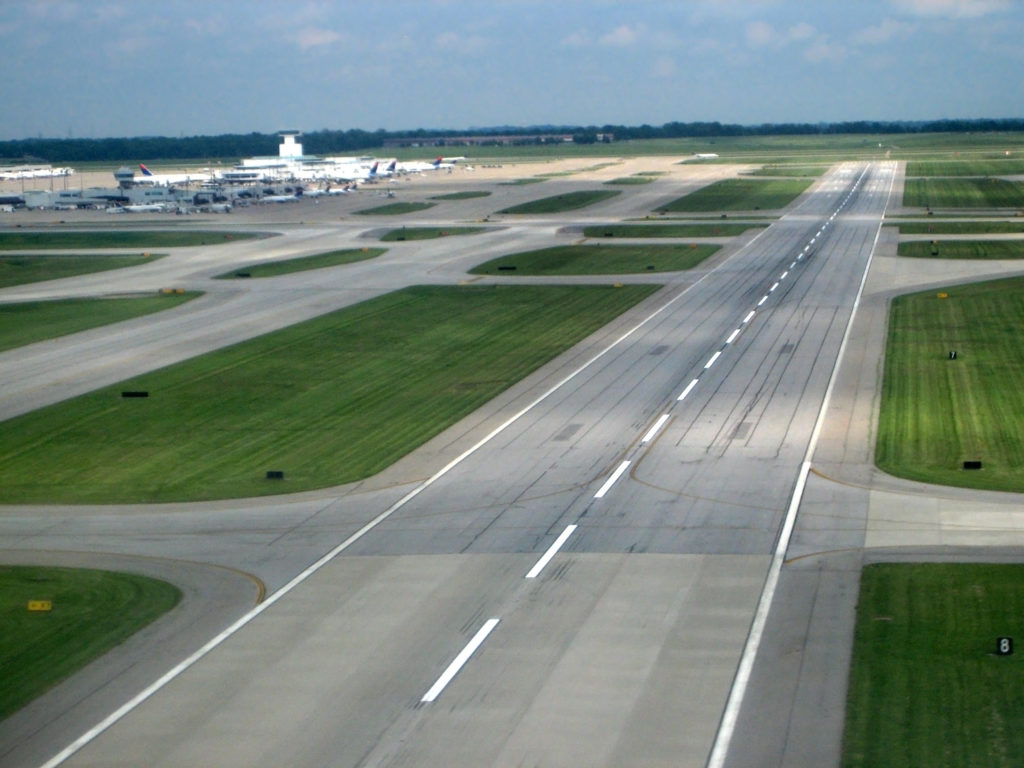The History of the Airport Runway: How Concrete Plays a Role in Flight

Earlier this year, Constructors, Inc was helping pave a terminal for a nearby airport in our home state of New Mexico. Frankly, most people might not know that there is, in fact, an airport in little Hobbs, New Mexico. But there is! And we were out there laying down some quality pavement to facilitate the coming in and out of aircraft.
As we poured the pavement, we began thinking about the wonders of flight and how pavement plays a great role in our ability to travel. Today’s modern airports are efficient facilities that use great engineering and architecture to ensure the safety and maneuverability of dozens of aircraft on any given day. From a small-town airport like Hobbs or to the biggest international airports of the country, concrete, pavement, and asphalt play a major role.
So we thought we’d take a look at the many great histories and engineering feats that we all run into when we get on a flight today. Many of these we don’t much think about and yet they have changed the way we live and the way we think about travel.
First There Were Wings — Getting Off The Ground
It was just the turn of the twentieth century when the Wright brothers got their first glider off the ground successfully. This was a great achievement and Orville and Wilbur knew that they were coming up on something big.
They worked tirelessly on this flying machine. The Wright Brothers, having a knack for engineering, knew they had to factor in the weight of the aircraft to the length and size of the wings. To carry the weight of the engine, propellers, and added structure the wing area had to be increased. Based on the estimated weight of the entire aircraft, they calculated power, thrust, and speed, coming to the conclusion that they required an 8 horsepower engine that generated 90 pounds of thrust in order to get to the 23 miles per hour speed. They had to carefully consider the wing rib construction, the fabric covering, and the wing struts. Ultimately as well, they had to consider the propulsion system and how exactly they would create a propeller and an effective connection to the power plant.
Then on that fateful day of December 17th, 1903, the Wright brother’s flying machine took off for the first time and flew less than half a mile. That short flight, however, set off a whirlwind of advancements and further research that would impact the world in a monumental way. The first commercial flight was on January 1st, 1914 in Tampa Bay. Florida.
The First Airports — Laying Down the Groundwork
As you might imagine, the first airports looked nothing like today’s JFK or DFW airports. Pilots would land the aircraft on any acceptable cleared piece of land. The first ‘airport’ happened in Ohio and it didn’t have a food court, endless snack machines, magazine racks, or gift shops. It was more like a cow pasture or bona fide piece of grass field. This was the Huffman Prairie Flying Field in Dayton, Ohio. There was little difference and that was that there was not exactly a runway or terminal for these first flying machines. Many of them were kind of catapulted into the air.
Change was a-coming thanks to our very own Henry Ford. The automobile pioneer built his own airport in Dearborn, Michigan using concrete for the purpose of providing a smooth take-off pad and landing for aircraft. This site is often deemed as the first ‘modern airport.’ Ford envisioned commercial airports and it wasn’t until 1928 that the two first major runways were installed.
History of the Runway and Terminals — How Concrete Surface Plays a Role
It took a bit longer for the appearance of the first airport runways—as we know it today— to come into play. The first official airport was in Albany, New York in 1908, but it took twenty years for them to pave the first runways.
Can you imagine taking a flight today without the runway? These are vital parts of our commercial air travel. These runways are of major importance and they can also be quite costly for airports. These are high-quality concrete and asphalt surfaces that need to withstand heavyweight. These surfaces, after all, have to handle and withstand thousands of takeoffs and landings a year. A common commercial aircraft can weigh hundreds of tons and with each runway seeing dozens (if not more of these) a day, they require high-quality man-made materials.
At most airports today, the runways are constructed of asphalt or concrete or a combination of both. The type of pavement choice often depends on several factors including ground conditions. Concrete is typically the choice for major and bigger commercial airports.
When It Comes to Pavement and Laying Down Concrete, Trust the Pros
When most people think of airports, they imagine the big commercial aircraft, the long hallways with people waiting to board, reading magazines, looking at their phones, or purchasing snacks at the endless rows of snack bars and food courts. As passengers, we don’t often think of the role concrete and pavement play in the whole affair. Here at Constructors, Inc we’re very proud of the concrete work we do across the state and region. We focus on quality and longevity because we know how important that surface is in the short and long term. If you need something paved or need concrete work, call us today.